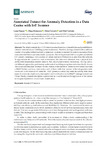Annotated Dataset for Anomaly Detection in a Data Center with IoT Sensors

Use this link to cite
http://hdl.handle.net/2183/26067Collections
- Investigación (FIC) [1682]
Metadata
Show full item recordTitle
Annotated Dataset for Anomaly Detection in a Data Center with IoT SensorsDate
2020-07-04Citation
Vigoya, L.; Fernandez, D.; Carneiro, V.; Cacheda, F. Annotated Dataset for Anomaly Detection in a Data Center with IoT Sensors. Sensors 2020, 20, 3745. https://doi.org/10.3390/s20133745
Abstract
[Abstract]
The relative simplicity of IoT networks extends service vulnerabilities and possibilities to different network failures exhibiting system weaknesses. Therefore, having a dataset with a sufficient number of samples, labeled and with a systematic analysis, is essential in order to understand how these networks behave and detect traffic anomalies. This work presents DAD: a complete and labeled IoT dataset containing a reproduction of certain real-world behaviors as seen from the network. To approximate the dataset to a real environment, the data were obtained from a physical data center, with temperature sensors based on NFC smart passive sensor technology. Having carried out different approaches, performing mathematical modeling using time series was finally chosen. The virtual infrastructure necessary for the creation of the dataset is formed by five virtual machines, a MQTT broker and four client nodes, each of them with four sensors of the refrigeration units connected to the internal IoT network. DAD presents a seven day network activity with three types of anomalies: duplication, interception and modification on the MQTT message, spread over 5 days. Finally, a feature description is performed, so it can be used for the application of the various techniques of prediction or automatic classification.
Keywords
Dataset
IoT
Sensors
IoT
Sensors
Editor version
Rights
Atribución 4.0 Internacional
ISSN
1424-8220
1424-8239
1424-8239






